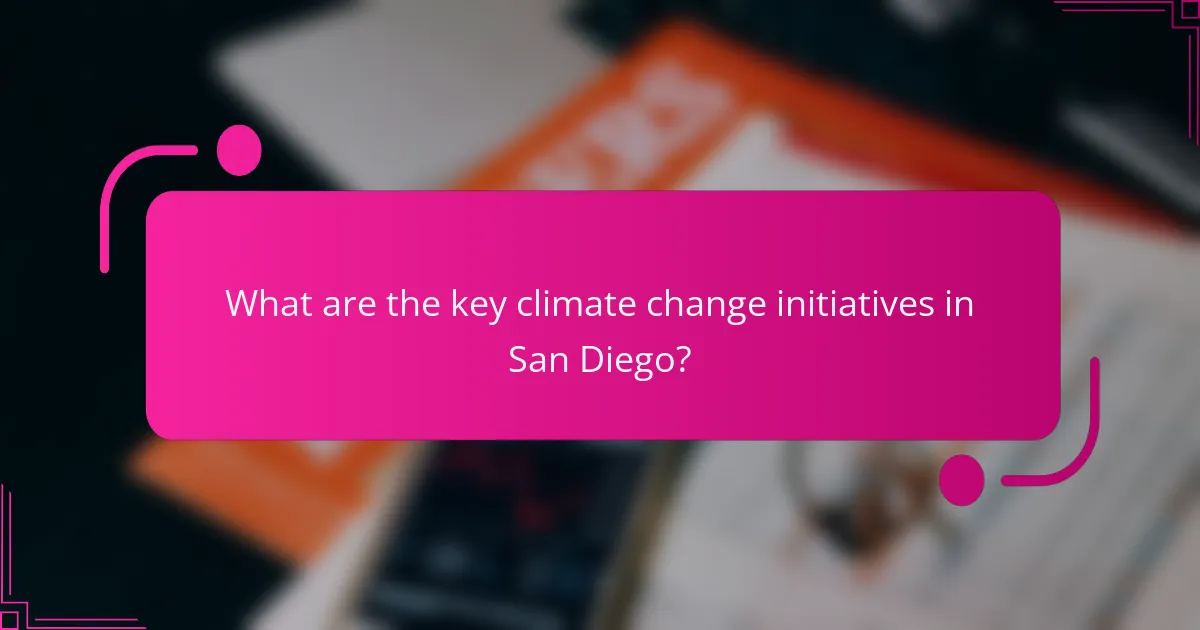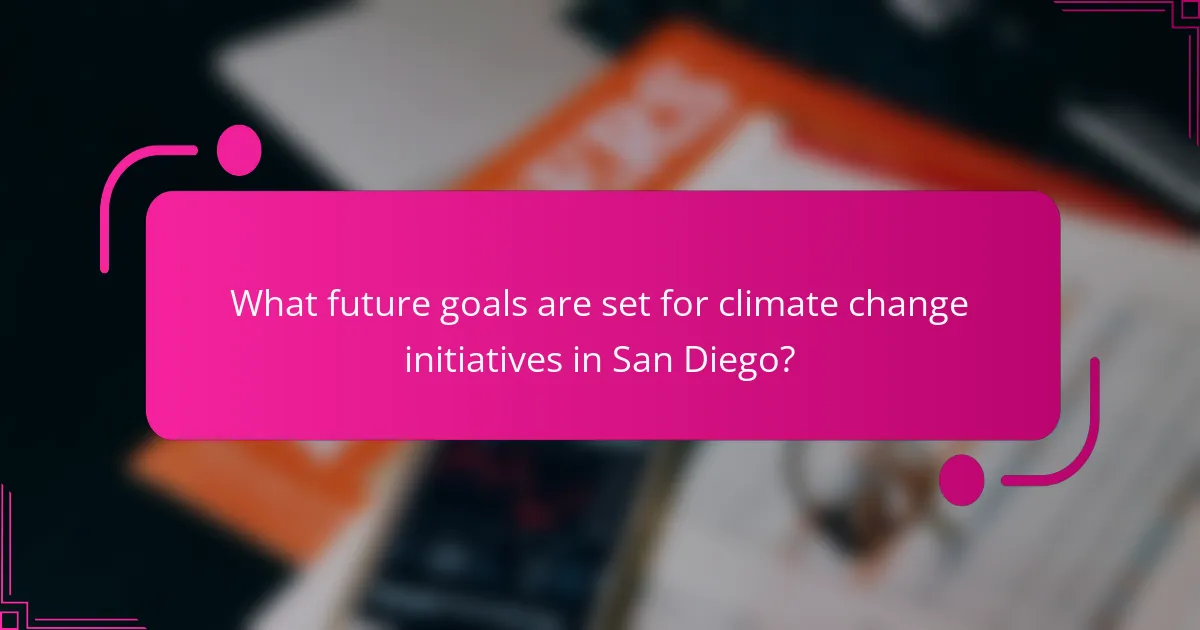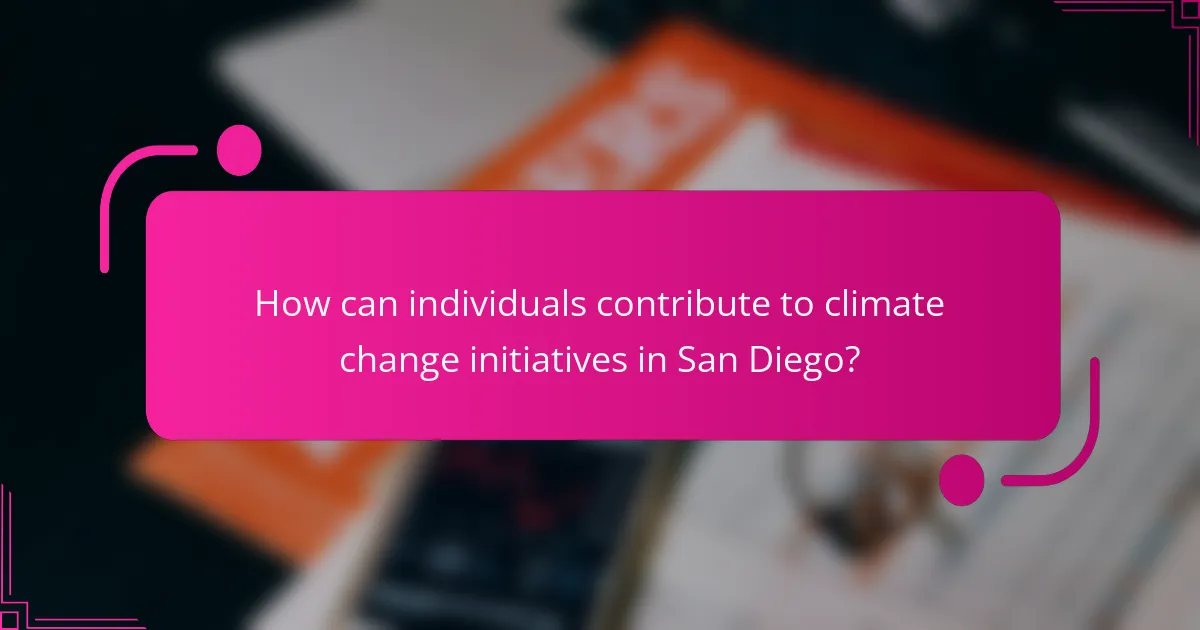
What are the key climate change initiatives in San Diego?
San Diego has implemented several key climate change initiatives. The Climate Action Plan aims for a 50% reduction in greenhouse gas emissions by 2035. It focuses on transitioning to 100% renewable energy. The city promotes electric vehicle use through charging infrastructure expansion. Additionally, urban forestry programs enhance carbon sequestration. San Diego also invests in climate resilience strategies to address sea-level rise. Community engagement is integral to these initiatives, fostering local involvement. These efforts position San Diego as a leader in climate action.
How do these initiatives address local climate challenges?
These initiatives address local climate challenges by implementing sustainable practices and reducing greenhouse gas emissions. They promote renewable energy sources, such as solar and wind, to decrease reliance on fossil fuels. The initiatives also focus on enhancing public transportation to reduce vehicle emissions. Additionally, they encourage community engagement through educational programs on climate resilience. Urban greening projects help mitigate heat and improve air quality. According to the San Diego Climate Action Plan, these efforts aim to achieve a 50% reduction in greenhouse gas emissions by 2035. This comprehensive approach ensures that local communities are actively involved in climate solutions.
What specific areas do these initiatives target for improvement?
The initiatives target specific areas such as reducing greenhouse gas emissions, enhancing energy efficiency, and promoting sustainable transportation. They also focus on improving water conservation and management. Additionally, these initiatives aim to increase community resilience to climate impacts. Evidence shows that San Diego’s Climate Action Plan sets a goal to achieve 100% renewable energy by 2035. This plan also includes strategies for reducing waste and increasing urban green spaces. Each targeted area is vital for mitigating climate change effects and fostering a sustainable future for the community.
What metrics are used to measure the success of these initiatives?
Success metrics for San Diego climate change initiatives include greenhouse gas emissions reductions, energy efficiency improvements, and community engagement levels. Greenhouse gas emissions are tracked through annual inventories. Energy efficiency is measured by the reduction in energy consumption across municipal buildings. Community engagement is assessed via participation rates in local sustainability programs. Additionally, progress towards renewable energy targets is monitored. These metrics provide a comprehensive view of the initiatives’ effectiveness and impact.
Why is local community involvement crucial in these initiatives?
Local community involvement is crucial in climate change initiatives because it fosters collaboration and enhances effectiveness. Engaged communities contribute local knowledge and resources. This participation leads to tailored solutions that address specific regional challenges. For example, San Diego’s community-driven projects have successfully reduced greenhouse gas emissions. Studies show that initiatives with strong local support achieve better sustainability outcomes. Moreover, community involvement encourages public awareness and education about climate issues. Increased awareness can lead to more sustainable practices among residents. Therefore, local engagement is essential for the success and longevity of climate initiatives.
How does community input shape the development of climate initiatives?
Community input significantly shapes the development of climate initiatives. Local feedback ensures that initiatives address specific environmental concerns. Engaging the community fosters collaboration between residents and policymakers. This collaboration leads to more effective and tailored solutions. For example, San Diego’s Climate Action Plan incorporated public workshops and surveys. These efforts collected diverse perspectives on sustainability priorities. Research indicates that community-driven initiatives are more likely to succeed. A study by the American Planning Association found that public participation enhances project acceptance and implementation. Therefore, community input is crucial for the success of climate initiatives.
What role do local organizations play in promoting climate action?
Local organizations play a crucial role in promoting climate action by mobilizing community engagement and resources. They facilitate awareness campaigns that educate the public about climate change impacts. These organizations often collaborate with local governments to implement sustainability initiatives. They also provide platforms for community members to participate in environmental projects. Research shows that grassroots movements led by local organizations can significantly influence policy changes. For instance, local advocacy has led to increased funding for renewable energy projects in San Diego. Their efforts help to foster a culture of sustainability within the community. By connecting residents with climate action resources, they empower individuals to make impactful changes.

What future goals are set for climate change initiatives in San Diego?
San Diego aims to achieve 100% renewable energy by 2035. This goal is part of the city’s Climate Action Plan. The plan also targets reducing greenhouse gas emissions by 50% from 2010 levels by 2035. Additionally, San Diego seeks to enhance urban tree canopy coverage by 20% by 2035. The city plans to increase the use of electric vehicles and expand public transit options. These initiatives are designed to improve air quality and promote sustainability. San Diego’s commitment is supported by community engagement and partnerships with local organizations.
How are these goals aligned with broader state and national strategies?
San Diego’s climate change goals align with broader state and national strategies through shared objectives in reducing greenhouse gas emissions. The state of California has set aggressive targets for carbon neutrality by 2045. San Diego’s initiatives support these targets by implementing renewable energy projects and promoting sustainable transportation. Nationally, the United States rejoined the Paris Agreement, committing to limit global warming. San Diego’s strategies complement this commitment by focusing on local adaptation and resilience measures. Furthermore, both state and national frameworks emphasize community engagement, which is a cornerstone of San Diego’s approach. This alignment ensures that local actions contribute to larger climate goals and enhance overall effectiveness.
What are the projected timelines for achieving these goals?
The projected timelines for achieving San Diego’s climate change goals span from immediate actions to long-term objectives. The city aims to reach carbon neutrality by 2035. Short-term initiatives include enhancing energy efficiency and increasing renewable energy sources by 2025. Mid-term goals focus on reducing greenhouse gas emissions by 50% by 2030. Long-term strategies involve comprehensive community engagement and infrastructure improvements over the next decade. These timelines align with state and national climate action frameworks.
What funding sources support these future goals?
Funding sources that support San Diego’s climate change initiatives include federal grants, state funding, and private investments. The federal government provides funding through programs like the Environmental Protection Agency’s Climate Pollution Reduction Grants. State funding is available through initiatives such as California’s Cap-and-Trade program, which allocates resources for climate projects. Private investments often come from environmental organizations and philanthropic foundations dedicated to sustainability. Local businesses also contribute through corporate social responsibility programs aimed at reducing their carbon footprint. These funding sources collectively enable the city to pursue its climate goals effectively.
What challenges do these initiatives face moving forward?
San Diego climate change initiatives face several challenges moving forward. Funding limitations hinder the implementation of new projects. Community engagement is often inconsistent, affecting participation levels. Regulatory hurdles can slow down the progress of initiatives. Additionally, the impact of climate change itself is unpredictable, complicating long-term planning. Competition for resources among various local projects creates prioritization issues. Lastly, political shifts can influence support for climate initiatives, leading to uncertainty in continuity.
How do political and economic factors influence the success of climate initiatives?
Political and economic factors significantly influence the success of climate initiatives. Political support can drive funding and policy changes necessary for implementation. For instance, when local governments prioritize climate action, they can allocate resources effectively. Economic factors, such as funding availability and market conditions, also play a crucial role. A strong economy can provide the necessary investments for sustainable projects. Conversely, economic downturns may hinder funding and support for climate initiatives. Historical examples show that regions with robust political backing and economic resources often achieve greater success in climate initiatives. San Diego’s local efforts demonstrate this relationship, as supportive policies have led to increased community involvement and investment in sustainable practices.
What strategies are in place to overcome these challenges?
San Diego implements several strategies to overcome climate change challenges. The city promotes renewable energy adoption through incentives and programs. These initiatives aim to increase solar panel installations on residential and commercial properties. San Diego also invests in public transportation improvements to reduce greenhouse gas emissions. This includes expanding the trolley system and increasing bike lanes. Community engagement is another key strategy. Local organizations facilitate workshops to educate residents about sustainability practices. The city has set ambitious goals, such as achieving 100% renewable energy by 2035. These efforts are supported by data from the San Diego Climate Action Plan, which outlines specific actions and targets for emissions reduction.

How can individuals contribute to climate change initiatives in San Diego?
Individuals can contribute to climate change initiatives in San Diego by participating in local environmental programs. They can volunteer for tree planting events organized by groups like the San Diego Urban Forest Council. Residents can reduce their carbon footprint by using public transportation or biking instead of driving. Engaging in community clean-up days helps to maintain local parks and beaches. Individuals can also advocate for sustainable policies by contacting local representatives. Supporting local renewable energy initiatives, such as solar panel installations, further aids climate efforts. Additionally, promoting and practicing recycling and composting within households contributes to waste reduction. Each of these actions collectively supports San Diego’s climate change initiatives.
What practical steps can residents take to support local efforts?
Residents can support local climate change initiatives by participating in community clean-up events. These events help reduce pollution and promote environmental awareness. Residents can also advocate for local policies that prioritize sustainability. Engaging with local government allows residents to voice their concerns and influence decision-making.
Joining local environmental groups can amplify residents’ impact. These organizations often organize educational workshops and campaigns. Residents can also reduce their carbon footprint by using public transportation or biking. This action decreases traffic congestion and lowers greenhouse gas emissions.
Additionally, residents can support local businesses that prioritize eco-friendly practices. Choosing to buy from these businesses encourages sustainable economic growth. Finally, residents can volunteer for tree planting initiatives. Trees absorb carbon dioxide and improve air quality, directly benefiting the community.
How can community members participate in local climate action programs?
Community members can participate in local climate action programs through various activities. They can join local environmental organizations focused on climate initiatives. Volunteering for tree planting or clean-up events is also effective. Attending community meetings helps individuals stay informed and voice their opinions. Members can advocate for sustainable policies by contacting local representatives. Participating in educational workshops enhances understanding of climate issues. Engaging in community-based renewable energy projects promotes sustainable practices. Supporting local businesses that prioritize eco-friendly methods fosters a greener economy. Lastly, sharing information on social media raises awareness and encourages others to join.
What resources are available for individuals looking to get involved?
Individuals looking to get involved in San Diego’s climate change initiatives can access various resources. The City of San Diego’s official website offers information on community programs and volunteer opportunities. Local organizations, such as the San Diego Climate Action Campaign, provide resources for community engagement. Additionally, the San Diego Audubon Society hosts events focused on conservation and climate education. Social media platforms often feature groups dedicated to climate activism in the region. Educational workshops and webinars are regularly organized by environmental nonprofits. Local libraries may also have materials and programs related to climate action. These resources enable individuals to actively participate in local climate initiatives.
What are the benefits of community engagement in climate initiatives?
Community engagement in climate initiatives enhances local participation and ownership. It fosters collaboration among residents, organizations, and local governments. Engaged communities are more likely to adopt sustainable practices. This leads to reduced carbon footprints and improved environmental outcomes. Studies show that community-led initiatives can increase awareness of climate issues. For instance, the “Community-Based Social Marketing” approach has effectively changed behaviors in various regions. Furthermore, engaged communities can advocate for policies that support climate action. This advocacy can result in stronger local regulations and funding for green projects. Overall, community engagement is crucial for the success of climate initiatives.
How does individual participation enhance the effectiveness of these initiatives?
Individual participation enhances the effectiveness of San Diego climate change initiatives by fostering community engagement and ownership. When individuals actively participate, they contribute diverse perspectives and ideas. This involvement leads to more comprehensive solutions tailored to local needs. Additionally, participation increases awareness and education about climate issues. Informed citizens are more likely to adopt sustainable practices. Studies indicate that community-led initiatives often achieve better outcomes than top-down approaches. For instance, research by the National Oceanic and Atmospheric Administration shows that local engagement can double the effectiveness of climate adaptation strategies. Overall, individual participation is crucial for the success and sustainability of climate initiatives.
What success stories illustrate the impact of community involvement?
Community involvement in San Diego’s climate change initiatives has led to significant success stories. One example is the “San Diego Climate Action Plan,” which engaged over 1,000 residents in its development. This collaborative effort resulted in strategies that reduced greenhouse gas emissions by 15% between 2010 and 2018. Another success is the “Community Choice Energy” program, which allows local residents to choose renewable energy sources. This initiative has increased the use of renewable energy to over 50%, showcasing community empowerment. Additionally, the “Urban Forest Program” involved volunteers planting over 10,000 trees, improving air quality and urban aesthetics. These stories highlight the tangible impact of community involvement in addressing climate challenges.
San Diego Climate Change Initiatives focus on local efforts aimed at reducing greenhouse gas emissions, promoting renewable energy, and enhancing community resilience. Key initiatives include the Climate Action Plan, which targets a 50% reduction in emissions by 2035 and a transition to 100% renewable energy. Community involvement is emphasized through educational programs and local engagement in sustainability projects, which have proven effective in achieving climate goals. The article also outlines the challenges faced, future goals, and the importance of individual participation in driving these initiatives forward.